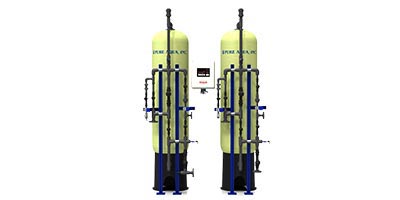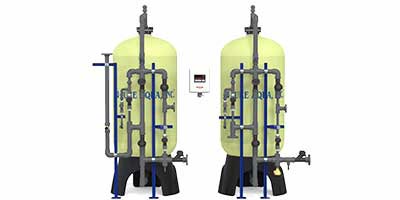Deionized Water Systems
Deionization is a process done when there is an immediate need of purified water distribution. It is imperative that deionization is performed when the water is close to being utilized since extremely high water purity degrades quickly.
Deionization systems work by replacing negative and positive molecules in the water with hydrogen (positive) and hydroxyl (negative) molecules. In effect, organic substances are removed through filtration which improves the quality of the water and prevents the formation of scale deposits forming. For this reason, deionized water is one of the most preferred options of use in factories and manufacturing facilities.
Easy to use solutions of deionized water:
- Simple to install systems and carry around to locations that require it
- Removal minerals via ion-exchange which prevents water spots and makes the need for polishing irrelevant
- The allowance of filters to bypass which increases the lifespan of the filter
Exchange Capacity
40K to 100K Grains
Service Flow Rates:
2 to 14 GPM
- Fiberglass (FRP) Tanks
- Diaphragm Valves
- Digital Stager
- Auto regeneration
Exchange Capacity
200K to 800K Grains
Service Flow Rates:
11 to 135 GPM
- Fiberglass (FRP) Tanks
- Diaphragm and Butterfly Valves
- Digital Stager or PLC
- Auto regeneration
Exchange Capacity
450 to 3000 Grains
Service Flow Rates:
0.13 to 1.25 GPM
- Standard and Big Blue Housings
- Softening or Deionizing Cartridges
- Testlight Quality Indicator
- Compact Units
Exchange Capacity
62K to 450K Grains
Service Flow Rates:
18 to 190 GPM
- Rubber Lined Carbon Steel Tanks
- Diaphragm and Butterfly Valves
- Digital Stager or PLC
- Auto regeneration
Pure Aqua is a leading provider of deionization solutions. Our deionized water systems are rugged, pre-engineered, pre-assembled, standardized units that minimize expensive installation and start-up costs. We have designed our di water system to maximize the efficiency and repeatability of the unit during the service and regeneration modes.
DI Water Systems
The Process of Deionization or Ion-exchange
In the context of water purification, ion-exchange is a rapid and reversible process in which impurity ions present in the water are replaced by ions released by an ion-exchange resin. The impurity ions are taken up by the resin, which must be periodically regenerated to restore it to the original ionic form. (An ion is an atom or group of atoms with an electric charge. Positively-charged ions are called cations and are usually metals; negatively-charged ions are called anions and are usually non-metals).
The following ions are widely found in raw waters:
|
Cations: |
Anions: |
|
Calcium (Ca2+) |
Chloride (Cl-) |
|
Magnesium (Mg2+) |
Bicarbonate (HCO3-) |
|
Sodium (Na+) |
Nitrate (NO3-) |
|
Potassium (K+) |
Carbonate (CO3-) |
|
Iron (Fe2+) |
Sulfate (SO4-) |
Ion Exchange Resins
There are two basic types of resin-cation-exchange and anion-exchange resins. Cation exchange resins will release Hydrogen (H+) ions or other positively charged ions in exchange for impurity cations present in the water. Anion exchange resins will release hydroxyl (OH-) ions or other negatively charged ions in exchange for impurity anions present in the water.
The application of ion-exchange to water treatment and purification:
There are three ways in which ion-exchange technology can be used in water treatment and purification: first, cation-exchange resins alone can be employed to soften water by base exchange; secondly, anion-exchange resins alone can be used for organic scavenging or nitrate removal from water; and thirdly, combinations of cation-exchange and anion-exchange resins can be used to remove virtually all the ionic impurities present in the feedwater, a process known as deionization. The deionizer purification process results in water of exceptionally high quality.
How Water Deionization Works
For many laboratory and industrial applications, high-purity water which is essentially free from ionic contaminants is required. Water of this quality can be produced by a di water system. The two most common types of deionization are:
- Two-bed deionization
- Mixed-bed deionization
Two-bed deionization
The two-bed deionizer consists of two vessels - one containing a cation-exchange resin in the hydrogen (H+) form and the other containing an anion resin in the hydroxyl (OH-) form. Water flows through the cation column, whereupon all the cations are exchanged for hydrogen ions.To keep the water electrically balanced, for every monovalent cation, e.g. Na+, one hydrogen ion is exchanged and for every divalent cation, e.g. Ca2+, or Mg2+, two hydrogen ions are exchanged. The same principle applies when considering anion-exchange. The decationised water then flows through the anion column. This time, all the negatively charged ions are exchanged for hydroxide ions which then combine with the hydrogen ions to form water (H2O).
Mixed-bed deionization
In mixed-bed deionizers the cation-exchange and anion-exchange resins are intimately mixed and contained in a single pressure vessel. The thorough mixture of cation-exchangers and anion-exchangers in a single column makes a mixed-bed deionizer equivalent to a lengthy series of two-bed plants. As a result, the water quality obtained from a mixed-bed deionizer is appreciably higher than that produced by a two-bed plant.
Although more efficient in purifying the incoming feedwater, mixed-bed plants are more sensitive to impurities in the water supply and involve a more complicated regeneration process. Mixed-bed deionizers are normally used to ‘polish’ the water to higher levels of purity after it has been initially treated by either a two-bed deionizer or a reverse osmosis unit.
Electrodeionization
Electrodeionization Systems remove ions from aqueous streams, typically in conjunction with reverse osmosis (RO) and other purification devices. Our high-quality deionization modules continually produce ultrapure water up to 18.2MW/cm. EDI may be run continuously or intermittently.
Deionized Water Systems Applications
Manufacturing plants utilize deionized water systems for its significant effectiveness in generating ultra pure water through the removal of unwanted impurities.
Deionized water treatment can also be beneficial in:
-
Cooling and anointing machines along with other applications
-
Manufacturing pharmaceuticals, cosmetics, and processed foods
-
Used in car washes for the final rinse
-
Power plants
- Boiler feed
Why is Water Deionization important?
Deionized water systems determine the chemistry of the process it is added to. Water deionizers are in-demand due to their exceptional capability of supplying decontaminated water when needed. This is a necessary feature since the level of purity in purified water degrades quickly.
 ENGLISH arrow_drop_down
ENGLISH arrow_drop_down
 ESPAÑOL
ESPAÑOL ???????
??????? PORTUGUÉS
PORTUGUÉS FRANÇAIS
FRANÇAIS




